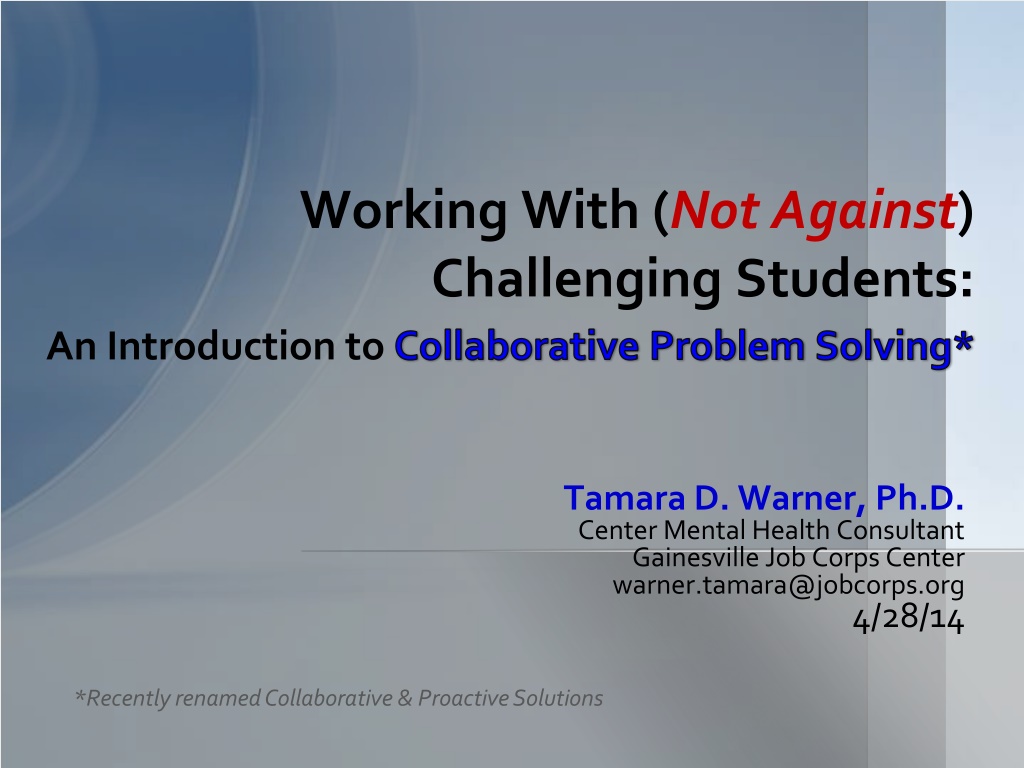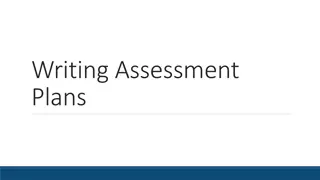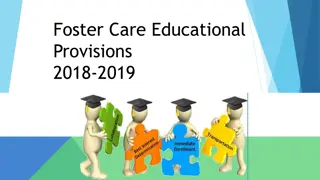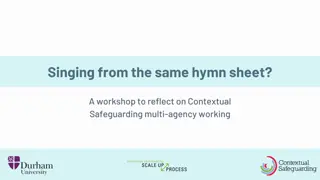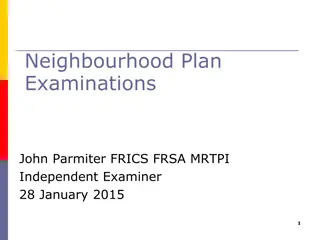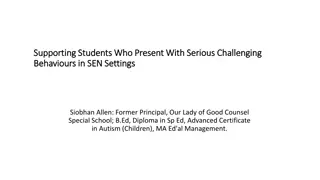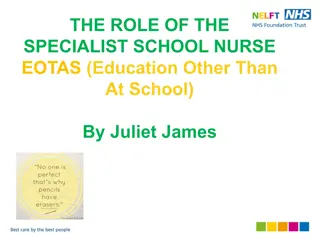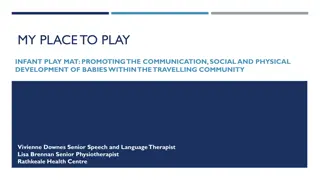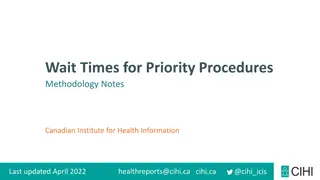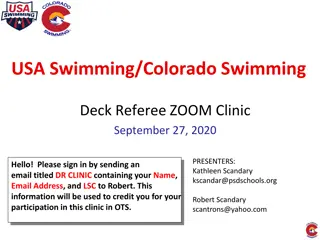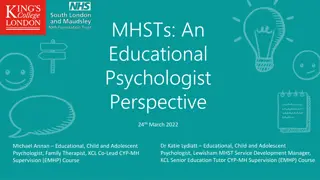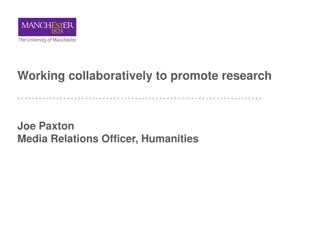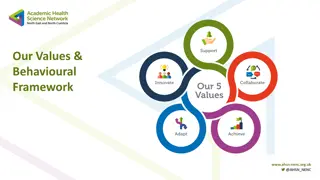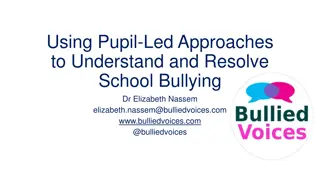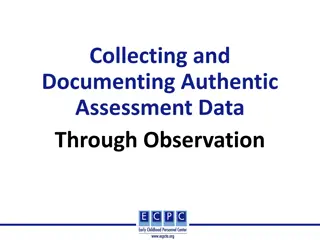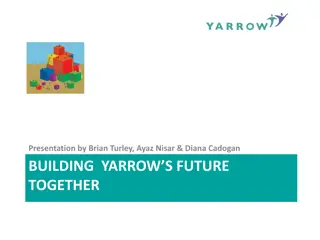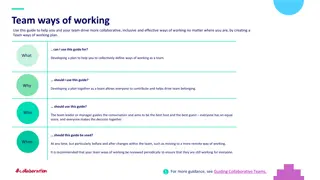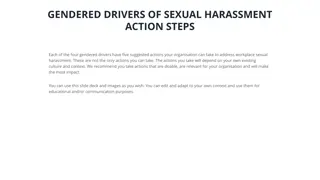Working Collaboratively with Challenging Students
Exploring the concept of Collaborative Problem Solving (CPS) as a transformative approach to working with challenging students. Dr. Tamara D. Warner introduces the idea of moving away from conflict towards cooperation by understanding the root of resistance in these students. The essence lies in shifting focus from proving rightness to collaborative problem-solving. Learn practical strategies through the lens of Dr. Ross Greene’s CPS method to address behavioral challenges in a proactive manner.
- Collaborative Problem Solving
- Challenging Students
- Behavioral Challenges
- Education
- Conflict Resolution
Download Presentation

Please find below an Image/Link to download the presentation.
The content on the website is provided AS IS for your information and personal use only. It may not be sold, licensed, or shared on other websites without obtaining consent from the author. Download presentation by click this link. If you encounter any issues during the download, it is possible that the publisher has removed the file from their server.
E N D
Presentation Transcript
Working With (Not Against) Challenging Students: An Introduction to Collaborative Problem Solving* Tamara D. Warner, Ph.D. Center Mental Health Consultant Gainesville Job Corps Center warner.tamara@jobcorps.org 4/28/14 *Recently renamed Collaborative & Proactive Solutions
What makes challenging students so challenging? We always seem to be in conflict with these students. 2 Collaborative & Proactive Solutions
Resistance Is The Problem Resistance is at the heart of all conflict. Resistance to hearing the other person s point of view. Investment in proving that we are right. Insistence on advancing some hidden agenda. Respect Authority Etc. 3 Collaborative & Proactive Solutions
How to Do It Differently Collaborative Problem Solving* (CPS) Developed by psychologist Dr. Ross Greene The Explosive Child: A New Approach for Understanding and Parenting Easily Frustrated, Chronically Inflexible Children Lost At School: Why Our Kids with Behavioral Challenges Are Falling Through the Cracks and How We Can Help Them http://www.livesinthebalance.org/ *Recently renamed Collaborative & Proactive Solutions 4 Collaborative & Proactive Solutions
http://livesinthebalance.org/research Conceptual/Theoretical Underpinnings: Greene, R.W. (2011). The aggressive, explosive child. In M. Augustyn, B. Zuckerman, & E. B. Caronna (Eds.), Zuckerman and Parker Handbook of Developmental and Behavioral Pediatrics for Primary Care. (2nd Ed.). Baltimore: Lippincott, Williams, & Wilkins, 282-284. Greene, R. W. (2010). Collaborative Problem Solving*. In R. Murrihy, A. Kidman, & T. Ollendick (Eds.), A Clinician s Handbook of Assessing and Treating Conduct Problems in Youth. New York: Springer Publishing, 193-220. Greene, R.W. (2010). Conduct disorder and oppositional defiant disorder. In J. Thomas & M. Hersen (Eds.), Handbook of Clinical Psychology Competencies. New York: Springer Publishing, 1329-1350. Greene, R. W., & Doyle, A.E. (1999). Toward a transactional conceptualization of oppositional defiant disorder: Implications for treatment and assessment. Clinical Child and Family Psychology Review, 2(3), 129-148. Research: Martin, A., Krieg, H., Esposito, F., Stubbe, D., & Cardona, L. (2008). Reduction of restraint and seclusion through Collaborative Problem Solving*: A five-year, prospective inpatient study. Psychiatric Services, 59(12), 1406-1412.CLICK HERE Greene, R.W., Ablon, S.A., & Martin, A. (2006). Innovations: Child Psychiatry: Use of Collaborative Problem Solving* to reduce seclusion and restraint in child and adolescent inpatient units. Psychiatric Services, 57(5), 610-616. CLICK HERE Collaborative & Proactive Solutions 6
Why do challenging students behave the way they do? They want to. They are attention-seeking. They don t care. They are not motivated. They don t know any better. They need clear consequences. People do well if they want to. 7 Collaborative & Proactive Solutions
A Different View People do well if they can. If someone is not doing well, it s because s/he is lacking the skills needed. Your role is to figure out what skills are lacking so you know what to teach. 8 Collaborative & Proactive Solutions
Old Explanation Dont Make Sense We all want attention. We all want our way. The problem arises when you do not have the skills to get what you want in an adaptive way. He just wants attention. He just wants his way. Manipulation requires a lot of skills forethought, planning, impulse control, etc. that most challenging students do not have. She s manipulating us. People do not choose to fail. If she has the skills to do well, why would she choose not to do well? Bad attitudes are the by-product of years of being misunderstood and over-punished by adults. Mental illness is a term to describe people with social, emotional and behavioral challenges. She s not motivated. He has a bad attitude. She has a mental illness. 9 Collaborative & Proactive Solutions
Collaborative & Proactive Solutions Problem: In homes, schools, mental health settings, therapeutic facilities, and in the juvenile justice system -- behaviorally challenging students are still poorly understood, and treated in ways that are punitive, adversarial, reactive, unilateral, ineffective, and counterproductive. This scenario places these students at serious risk for a variety of adverse outcomes. Solution: CPS is a non-punitive, non- adversarial, proactive, collaborative, skill- building, relationship- enhancing intervention designed to teach lagging skills, durably solve problems and reduce challenging behavior. CPS operates on the principle that students do well if they can. 10 Collaborative & Proactive Solutions
The4Main Concepts of CPS Lagging Skills Unsolved Problems Unmet Expectations How to Handle Unmet Expectations 11 Collaborative & Proactive Solutions
Not Poor Motivation, but Lagging Skills Do the challenging students you know have any of the following problems? Difficulty handling transitions, shifting from one mindset or task to another Difficulty doing things in a logical sequence or prescribed order Difficulty persisting on challenging or tedious tasks Poor sense of time Difficulty maintaining focus Difficulty considering the likely outcomes or consequences of actions (impulsive) Difficulty considering a range of solutions to a problem Difficulty expressing concerns, needs, or thoughts in words Difficulty understanding what is being said 12 Collaborative & Proactive Solutions
Lagging Skills Do the challenging students you know have any of the following problems? Difficulty managing emotional response to frustration so as to think rationally Chronic irritability and/or anxiety significantly impede capacity for problem-solving or heighten frustration Difficulty seeing the grays /concrete, literal, black-and-white thinking Difficulty deviating from rules, routine Difficulty handling unpredictability, ambiguity, uncertainty, novelty Difficulty shifting from original idea, plan, or solution Difficulty taking into account situational factors that would suggest the need to adjust a plan of action 13 Collaborative & Proactive Solutions
Lagging Skills Inflexible, inaccurate interpretations/cognitive distortions or biases (e.g., Everyone s out to get me, Nobody likes me, You always blame me, It s not fair, I m stupid ) Difficulty attending to or accurately interpreting social cues/poor perception of social nuances Difficulty starting conversations, entering groups, connecting with people/lacking other basic social skills Difficulty seeking attention in appropriate ways Difficulty appreciating how his/her behavior is affecting other people Difficulty empathizing with others, appreciating another person s perspective or point of view Difficulty appreciating how s/he is coming across or being perceived by others 14 Collaborative & Proactive Solutions
In CPS, the diagnosis doesnt matter Some of the lagging skills were in the areas of: Attention and memory Receptive and expressive language Social cognition and social skills (including theory of mind) Emotion regulation Executive Functioning (cognitive flexibility, planning, sequencing, time management, etc.) The key is to identify the skill deficits underlying the behavioral difficulties (most have several). Most skill deficits fall in 3 areas: cognitive inflexibility, low frustration tolerance, and poor problem solving. 15 Collaborative & Proactive Solutions
The4Main Concepts of CPS Lagging Skills Unsolved Problems Unmet Expectations How to Handle Unmet Expectations 16 Collaborative & Proactive Solutions
Unsolved Problems Challenging students are not challenging every minute. They re challenging sometimes, under certain conditions, usually when the environment is demanding skills they do not have (or do not have very well) or when the environment is presenting problems they aren t able to solve. 17 Collaborative & Proactive Solutions
Unsolved Problems Q: When is challenging behavior most likely to occur? DEMANDS A: When the demands being placed on a student exceed his/her capacity to respond adaptively. SKILLS Some students have the skills to handle stress; others do not. 18 Collaborative & Proactive Solutions
Unsolved Problems When the demands being placed on a student exceed his/her capacity to respond adaptively. Spectrum of responses to high stress MODERATE Screaming, swearing, hitting, kicking, destroying property, truancy EXTREME MILD Self-induced vomiting, cutting, drinking, using drugs, stabbing, shooting Cry, sulk, pout, whine, withdraw Learning how to handle high levels of stress is itself a skill. Most challenging students have not developed adequate coping skills andproblem solving skills. 19 Collaborative & Proactive Solutions
Unsolved Problems A situational analysis provides valuable information about the circumstances that precipitate social, emotional and behavioral challenges. Circumstances = Unsolved Problems Also called triggers or antecedents Examples: Becoming unfocused (wandering around room, asking to go to the bathroom) when asked to do a writing assignment Refusing to do an assignment when paired with a particular classmate An adult saying no is not specific enough. Need to know what the adult is saying no to. 20 Collaborative & Proactive Solutions
New Lenses and a New Tool Behind every challenging behavior is an unsolved problem or lagging skills (or both). Lagging skills are the why of the challenging behavior. Unsolved problems are the who, what, when and where. 21 Collaborative & Proactive Solutions
Assessment Assessment of Lagging Skills and Unsolved Problems (ALSUP) Challenging episodes will now be highly predictable. Take a proactive approach to teaching skills and solving problems rather than waiting for problem behaviors to occur. Many challenging students will have many lagging skills and unsolved problems. Because you can t fix everything at once, you will need to prioritize which skills/problems to tackle first. 22 Collaborative & Proactive Solutions
Summary So Far Changing the Lens on Challenging Behavior Challenging behavior is the result of lagging skills (students do well if they can) rather than as poor motivation (students do well if they want to). A wide range of lagging skills can set the stage for challenging behavior. Challenging behaviors usually occur in response to predictable triggers, circumstances, or unsolved problems. 24 Collaborative & Proactive Solutions
Summary So Far Changing the Lens on Challenging Behavior Applying consequences does not teach lagging skills or teach students how to solve problems. First step: identify the skills that are lacking and the unsolved problems that are precipitating challenging episodes (ALSUP). Achieve a consensus so that everyone can work together to help the student. 25 Collaborative & Proactive Solutions
The 4Main Concepts of CPS Lagging Skills Unsolved Problems Unmet Expectations How to Handle Unmet Expectations 26 Collaborative & Proactive Solutions
Expectations For Educators Students will: Learn the material and skills needed to do well (pass tests, get certifications, etc.) Develop a love of learning for the profession they will be entering Learn professionalism & employability skills Conduct themselves in ways that are safe, respectful & don t disrupt the learning of their classmates You want to teach in a way that is fair, respectful, humane and effective. 27 Collaborative & Proactive Solutions
Handling Unmet Expectations Three Options: Plan A is when adults impose their will (most popular but least effective). Plan C involves dropping an expectation completely, at least temporarily. Plan B is Collaborative & Proactive Solutions a process in which the student and adult are engaged in resolving a problem or unmet expectations in a realistic and mutually satisfactory manner. 28 Collaborative & Proactive Solutions
Plan A - Scenarios A student is badgering one of his classmates and causing the classmate to become agitated. The agitated student has already asked the student to stop badgering her. Teacher: Go stand in the hallway now! Come back when you re ready to treat people kindly. Student: I m not doing this assignment unless I can work with my friend. The teacher has already made it clear that he expects the student to partner with a different student. Teacher: You are not working with your friend. You better get with the program or I ll have to do a negative write-up. A student is distracting his classmates because he doesn t understand an assignment and the teacher says, Malcolm, let s talk about it at my desk so we don t disturb your classmates. Malcolm refuses. Teacher: If you don t come up to my desk NOW, you ll have to go the CSIO s office. 29 Collaborative & Proactive Solutions
Plan A - Problems Plan A greatly heightens the likelihoodof challenging behavior in challenging students. Most challenging episodes are precipitated by an adult responding to an unmet expectation using Plan A. Plan A doesn t help us figure out why the student isn t meeting our expectations in the first place. Plan A doesn t teach lagging skills or durably resolve the problem giving rise to challenging behavior. Does Plan A qualify as fair, respectful, humane, or effective treatment of a student? 30 Collaborative & Proactive Solutions
Plan C Plan C involves dropping an expectation completely, at least temporarily. When you re using Plan C, you re not solving any problem or teaching any lacking skills. But Plan C can help adults remove low-priority expectations, thereby helping a student to be more available to work on higher-priority problems or skills and reducing the likelihood of challenging behavior. Example: Student who repeatedly sharpens his pencil. 31 Collaborative & Proactive Solutions
Plan C -Concerns Q: Isn t Plan C the same thing as giving in ? A: No. Giving in is when you start with Plan A and end up using Plan C because the student is making your life miserable. When you start with Plan C , your reasoning is: I know what skills this student is lacking. I also know what unsolved problems are reliably precipitating her challenging behavior. I know which skills we re working on and what problems we re trying to solve right now, and this is not one of them. I m doing to drop this expectation, at least for now, because I know I can t fix everything all at once. 32 Collaborative & Proactive Solutions
Plan B Plan B is Collaborative & Proactive Solutions Plan B helps teachers (and others) clarify and understand a student s concernsabout or perspective on a particular problem. Plan B also helps the student understand the teacher s concerns about the problem Plan B helps teachers and students work together toward mutually satisfactory solutions so that both parties concerns are addressed, the problem gets solved and, most importantly, lagging skills get taught. 33 Collaborative & Proactive Solutions
The4Main Concepts of CPS Lagging Skills Unsolved Problems Unmet Expectations How to Handle Unmet Expectations 34 Collaborative & Proactive Solutions
Using Plan B When to use Plan B Rationale for using Plan B Goals of Plan B Implementing Plan B (3steps) including common problems 35 Collaborative & Proactive Solutions
Plan B There are two ways to use Plan B. EmergencyPlan B and Proactive Plan B Emergency Plan B = crisis managementwhen a student is beginning to show signs of challenging behavior. Proactive Plan B = crisis prevention Because challenging behavior tends to be highly predictable, you don t have to wait until the student is in the midst of a challenging episode to try to solve the problem that caused the episode. The goal is to get the problem solved or the skills taught proactively. 36 Collaborative & Proactive Solutions
Why use Plan B instead of Plan A? If you want to help a student, you are going to need to develop a helping relationship. Goals of this helping relationship: Help students not just better manage a given problem but to apply the learning to sort out other problems and to preventing problems from occurring in the first place. Provide students with the tools to become more effective self-helpers and more responsible agents of change in their own lives. 37 Collaborative & Proactive Solutions
Helping Relationship Helping is a working alliance, a two-way collaborative process. Helping is NOT something that teachers do to students; it is a process that teachers and students work through together. Exercise Think about the qualities that you d seek in someone you were hoping to help you? 38 Collaborative & Proactive Solutions
Helping Relationship Qualities Someone who cares Who you feel you can trust Who takes time to listen to you Who asks the right questions and truly tries to understand your concerns Who has the wisdom and know-how to help in ways that are effective and long-lasting Who involves you in the process 39 Collaborative & Proactive Solutions
Why use Plan B instead of Plan A? Plan B is a relationship-building process. Plan A pushes students away. 40 Collaborative & Proactive Solutions
Goals of Plan B 1. Pursue unmet expectations and ensure that your concerns about a given student s challenges are addressed. 2. Solve the problems precipitating a student s challenging episodes in a collaborative, mutually satisfactory and durable way. 3. Teach the student the skills s/he is lacking. 4. Reduce challenging behavior. 5. Create a helping relationship. 41 Collaborative & Proactive Solutions
Plan B - Steps 1. Empathy 2. Define the problem 3. Invitation 42 Collaborative & Proactive Solutions
Plan B Empathy Step The goal of the empathy step is to achieve the best possible understandingof a student s concern or perspectiverelated to a given problem. Just like adults, students have legitimate concerns. However, most students are accustomed to having their concerns superseded by the concerns of teachers/adults. 43 Collaborative & Proactive Solutions
Plan B Empathy Step To get the information-gathering process rolling, start by making a neutral observation about a challenge or problem a student is having. Example 1: Adult (Empathy step, kicking off Proactive B): I ve noticed that you ve been getting pretty mad at some of the other students lately. Example 2: Adult (Empathy step, kicking off Proactive B): I ve noticed that you haven t been getting much work done lately. 44 Collaborative & Proactive Solutions
Plan B Empathy Step Observationmust be neutral. Requires the adult to resist the temptation to jump to biased conclusions about the student s concerns. Example 1: (Getting mad problem) I guess you don t care about hurting other students. You know, you can t always have things your own way. Example 2: (Getting work completed problem) You must not be very interested in completing this program. The work must be too hard for you. 45 Collaborative & Proactive Solutions
Plan B Empathy Step Problem #1: Some students aren t very specific about their concerns. They are more likely to verbalize a solutionrather than a concern. Your job is to make sure it s the student s concerns or perspective that ultimately get onto the table. A very general clarification question like What s up? can be helpful. 46 Collaborative & Proactive Solutions
Plan B Empathy Step Problem #2: Some adults skip or rush through the empathy step because they assume they already know what a student s concern or perspective is. Most times, the adult is dead wrong. Problem #3: While feeling heard and understood tends to be calming for most students, some need assurance that you re not doing Plan A (imposing your will at all costs). Use reassuring statements like: I m not saying no, I m not saying you have to, or I m not saying you can t. I m not mad, You re not in trouble, I m not going to tell you what to do, and I m just trying to understand. 47 Collaborative & Proactive Solutions
Plan B - Steps Empathy 2. Define the Problem 3. Invitation 48 Collaborative & Proactive Solutions
Plan B Define the Problem Step The teacher (supervisor) brings his/her concern about the problem or unmet expectation to the table. Define the Problem is defined as two concerns that have yet to be reconciled. If the only concern on the table is the teacher s concern, you re using Plan A. If the only concern on the table is the student s concern, you re using Plan C. Plan B is the only plan that puts both concerns on the table. 49 Collaborative & Proactive Solutions
Plan B Define the Problem Step Like students, adults are prone to puttingsolutions on the table instead of concerns. Plan B is dead in the water if there are 2 solutions on the table dueling solutions or a power struggle When a teacher puts a solution on the table during the Define the Problem step, the process shifts from Plan B Plan A. You need to use speak calmly to me or I won t help you. You have to do the writing or you ll never get better at it. Win/lose vs. win/win ( same team attitude) 50 Collaborative Problem Solving
